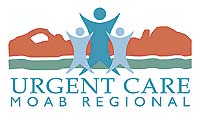How To Go With The Flow |
About 16 years ago in my 38 year history as a bodymind therapist, I was scheduled to meet with the director of a remote retreat center in the beautiful mountains of western North Carolina to pitch my idea for a weekend workshop on the body/mind work I do. Understandably, I was nervous – the stakes were high. Landing this workshop could help my business grow, especially since people came from all over the country to attend this center.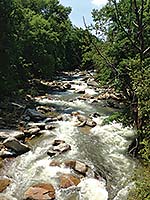
As I was driving this scenic, winding, river valley road, I was keenly aware of the mounting tension in my chest and bell–a common area of the body for many people to manifest anxieties. I realized that I was trying to “hold myself together” both emotionally and physically in attempts to calm my nerves. While common for many of us, that holding pattern was NOT helping me relieve my apprehensions so I could present myself well in this meeting.
Trained as a counselor and bodywork practitioner, I clearly understood the connections between my rolling stomach and my nervousness–my tight chest and not wanting to breathe and amplify my unexpressed feelings–my slumped torso behind the wheel of the car. All these body clues about my bracing against my anticipated meeting were increasing my anxiety.
Aware that this had been a common body pattern for me when anxious, I found my pattern of tension hard to release. I was almost frozen–my body locked in a tight place like a rock. My usual strategies for releasing such tensions were not successful. My stomach ache increased and I didn’t dare try to eat my lunch which would surely have led to more gastric upset. Hmmm, what to do....
I was driving a mountain road alongside a river–a beautiful river that winds down the valley, tumbling over rocks as it flows nonstop. Hmmm…what if I asked my body to flow like that river – to easily tumble downhill – to splash and cascade over and around the rocks and debris, undeterred by any obstacles? What if I could imagine my guts and chest flowing like that carefree river? I started to notice softening in my body, tissues starting to ease–I’m onto something!! As my torso eases, I start to sit up a little taller and breathe a little more deeply. I begin to notice this scenic river valley as my attention widens beyond the literal bounds of my body. I breathe even more deeply. Now I can notice how the sun is shining brightly and the sky is an amazing blue with a few puffy, white clouds. My entire body starts to gently shift, lengthen, release and open and continued the more I noticed both the beauty around me and the ease with which Mother Nature goes about her business.
Because I was in such an anxiously self-focused place, I hadn’t minded traveling slowly behind a fully loaded semi truck. Other cars were scrambling to pass us–2 vehicles at a time. They obviously had places to be (how many times had I been in a self-imposed hurry...). I asked myself to stay behind the semi as we started to climb out the valley despite how slowly we were moving. Maybe I could learn something here too; driving that slowly, I began to take in the valley views as the car climbed–views by which I would normally have sped. As my vision was catching an ever increasing view, my perspective about the forthcoming meeting began to shift as well to hold a larger context.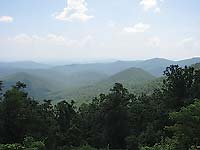
By the time I neared my retreat destination, I was literally in a different place–lighter, easier, more optimistic, breathing easily. Mother Nature and metaphor are two great healers when we pause to recognize them in our physical and biological landscape. These are some of the tools I use in my practice to help people make difficult journeys through personal transitions, to ease body aches and pains that inhibit free movement, and to heal from chronic conditions with all their complexities. The body work helps to build awareness of tensions, how to release them, and calms the overly agitated, stressed nervous system. Making the connection between physical complaints and stressful and unhappy areas of one’s life is key. Developing a deeper connection to one’s inner wisdom to guide decisions and actions builds one’s inner resources and confidence. Above all, I steadfastly support, encourage and affirm your ability to heal. That’s the nature of an integrated approach to healing – where the mind, body, and spirit meet to heal. (By the way, I landed the deal, conducting two workshops each year over the next 5 years.)
Did something you read call to you in intuitive or practical way? Call me. Let’s talk and discuss how my work can benefit your specific issues. Christina Myers 937-284-2190 150 E. Center St. Moab
|
New USU-Moab
Nursing Professor Enhances Local Program |
Utah State University-Moab strengthens its growing nursing program by hiring Connie Wilson, RN, as a Professional Practice Assistant Professor in Nursing. Wilson has over 20 years of nursing clinical experience and 18 years of clinical teaching experience.
“My goal is to pass on the skills I’ve acquired over the years to the next generation of nurses,” said Wilson. “I’ve come to the point in my career where I want to teach more than just how to start an IV or deliver a baby. I want to teach safety, critical thinking, and therapeutic communication.”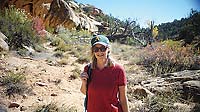
Based on projection models of age and population, by the year 2030 Utah is projected to only have 299 registered nurses per 100,000 people. USU’s regional campus system is striving to increase the number of nurses to help create a state with quality care from highly-trained nurses.
Wilson and her family have lived in Moab for 21 years. Wilson says one of USU-Moab’s biggest benefits, along with the other locations, is the outreach to more remote communities. “Every resident in Moab, and other Utah communities, deserves a chance to pursue education beyond high school. I’m excited to do my part to train and prepare the next generation of nurses.”
Wilson experienced first-hand the importance of USU-Moab’s nursing program while she worked at Moab Regional Hospital. “Our hospital would not be functioning at such a high level without the multiple USU nursing students who came to work with us after graduating.” USU-Moab continues to partner with Moab Regional Hospital and other healthcare centers to provide students with clinical, hands-on experience.
Wilson will begin teaching this semester and is looking forward to the growth and development of USU-Moab’s nursing program.
|
Integral Brain Health |
 The practitioner at Integral Brain Health has been trained and certified in the Crossinology® Brain Integration Technique for brain integration, advanced physiology, muscle reactivation with pain removal (including Migraine pain), chakra balancing, allergy relief as well as asthma control, emotional balancing for severe trauma, sadness, and hopelessness, eradicating ADD/ADHD, Dyslexia, and significant learning difficulties (including memory, retention, and memory recall). The Crossinology® Brain Integration Technique also helps those diagnosed with Autism, Bi-Polar, Schizophrenia, Substance Addiction, and Anxiety find relief from many of the symptoms of their difficulties. The practitioner at Integral Brain Health has been trained and certified in the Crossinology® Brain Integration Technique for brain integration, advanced physiology, muscle reactivation with pain removal (including Migraine pain), chakra balancing, allergy relief as well as asthma control, emotional balancing for severe trauma, sadness, and hopelessness, eradicating ADD/ADHD, Dyslexia, and significant learning difficulties (including memory, retention, and memory recall). The Crossinology® Brain Integration Technique also helps those diagnosed with Autism, Bi-Polar, Schizophrenia, Substance Addiction, and Anxiety find relief from many of the symptoms of their difficulties.
When students find it hard to learn at school, it is not because they are Lazy or that they are incapable of learning. It is because they cannot process the information in their brain as other Ace students. Provide the positive change for your child. When a child is not successful at learning and they feel that they are not equal to other students, they become behavior problems for parents, teachers, and the community. Give your child the edge and contact Integral Brain Health right away.
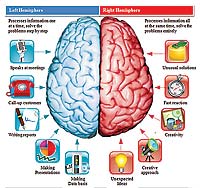 The root of the problem The program addresses malfunctioning and non-functioning pathways in the brain. These errant pathways block the flow of information in the brain, which often presents as issues identified above. The root of the problem The program addresses malfunctioning and non-functioning pathways in the brain. These errant pathways block the flow of information in the brain, which often presents as issues identified above.
How does the Crossinology® Brain Integration Technique work?
The Crossinology® Brain Integration Technique can correct brain malfunction in cases where there is no organic brain damage in as little as six to twelve hours - that's it! No treatment plans, follow-up sessions, or adjustments. Best of all, your integration is permanent. Unless you have another significant trauma, your brain will stay integrated for the rest of your life!
Using Kinesiology, acupressure, and other non-invasive and drug free methods, your BIT Practitioner addresses the following areas: tastes, sounds, or something that they see.
|
What is Posture Fitness? |
Are you slouching as you read this? That’s okay! Yes, you read that right: I am a certified posture coach, and I’m telling you that it is okay to slouch sometimes. Sitting, standing, and moving in ideal alignment—all the time—is not realistic. However, not having pain when you assume these static positions and go about your daily activities is realistic and attainable.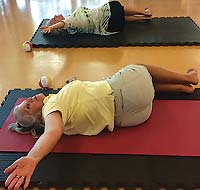
Many of us go to the gym, walk and hike outside, or take group exercise classes to get “fit.” We strive to be in better condition and improve the health of our muscles, lungs and heart. Having “fitness” in your posture is no different. It means you have the strength, flexibility and stamina in your soft tissues to achieve and maintain an aligned position in your structure. When you have “fit” posture, you can easily and painlessly move into and out of “good” and “bad” alignment. Life doesn’t always accommodate optimal posture–like when you drop your keys under your seat in the car, which often requires contorted positions to retrieve. But you should be able to recover your keys, or slouch for a time, without enduring pain or becoming stuck in that posture.
Unfortunately, many of us do become fixed in a misaligned position. The body needs regular reminders of what straight and “fit” posture looks and feels like. The Posture Fitness class offered at the Moab Recreation and Aquatic Center does this through small, specific movements, starting with core alignment and conditioning. Similar to yoga and Pilates, the class emphasizes body-mind awareness, breath, and muscle balance.
Awareness is the first step toward change. In this class I foster an attitude of non-judgement and acceptance toward your body. A deep, mindful connection with how you move, what you feel, and any asymmetries between your right and left sides allows you to take action toward better alignment, less pain and greater performance.
I know you may be skeptical of trying something new, so I’ve created two low-risk offers to spur you into action.
1. Your First Class is Free! Try the class at any time for no charge.
2. Bring a Friend Incentive! Introduce someone to the class, and their class is free, and yours is half price.
Join others who have already benefited from the Posture Fitness class:
"After five Posture Fitness classes at the Moab Recreation and Aquatic Center, my posture has begun to change—especially as I add this new awareness to my existing Pilates and yoga practices. As a 70-year-old woman, it amazes me how powerful and effective this ‘seemingly’ simple group of exercises is. Jessica Kisiel is very thorough, and even in a group class can hone in on my specific misalignments and movements. Highly recommended!"
—Constance Shambo
“Jessica’s Posture Fitness class is awesome! I never realized that my chronic foot pain was attributable to my posture issues. After 3 sessions, my pain is negligible!”
—Carol Mayer, MRAC Member & Avid Hiker
Class Details
Sept. 18 – Dec 11, 2017
Mondays @ 11:30 – 12:30 pm
Moab Recreation and Aquatic Center
Investment: $10 /class, $45/5-punch card, $80/10-punch card
Jessica Kisiel, MS, is a local wellness professional specializing in injury recovery and pain management through alignment. She is certified by the Postural Restoration Institute® and Egoscue University®. Learn more by signing up for her newsletter at thepfathlete.com
|
Yoga, the Seasons, and You!
|
With the start of September I always feel relief to have made it through the summer! Later sunrises, earlier sunsets, and the tease of cooler temperatures greet my senses this month. Travelers and residents alike come to intimately know the heat of the southwestern summer. What they may not know is that yoga offers tools to help us acclimate, as well as transition with more ease through the seasons.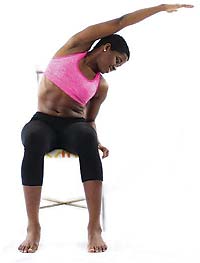
Yoga originated in India thousands of years ago. Yoga, which many in the West define as physical postures (asanas), is closely related to Ayurveda, the traditional medicine of India. Ayurveda also developed over a similar time period, and these two practices complement one another to help achieve lasting health, vitality and ease.
Ayurveda looks to the natural world, elements and seasons to find optimal health. Ancient yogis and practitioners of Ayurveda noticed that the outside world mirrors the inner world inside our own body. They found that like increases like, and opposites balance. Think about this – when you are cold a sweater and hot cup of tea would help you warm up much better than a glass of ice water. On a hot day when you are roasting that same sweater and cup of tea doesn’t sound as appealing, but the ice water sure does! While this is a simple example you can use this principle to help live comfortably in your environment through easy, daily practices.
Consider the qualities of the summer here: it’s hot, dry, the sun is sharp and winds can be a blow dryer. Summer is the perfect time to enjoy cooling foods such as cucumbers, water melon, hummus, and lots of seasonal vegetables. It is also the perfect time to use the practice of yoga to aid in cooling off. Simple techniques such as looking down at the ground or horizon during practice, extending your exhales, as well as choosing postures that create more space in the body all assist in keeping cool.
I love to practice side bends this time of year. Try it yourself – sit on a chair or the floor, take one hand out to your side and hold onto the chair or place your hand on the floor next to you. Lift the other arm up and overhead so your bicep is by your ear. Lean towards your grounded hand (the one on the chair or floor), and reach towards that side with your lifted arm. Keep both sit bones, or your whole seat, firmly planted on the chair or ground. Breathe deeply for a few moments as you close your eyes. Repeat on the other side when you are ready. 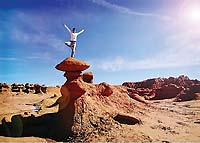
This principle of opposites balancing can help us as the season shifts into fall. What are some qualities of fall here? Beauty is the first thing that comes to my mind! The weather mellows, winds are less gusty and cooler, and fall flowers return. This is the time to prepare for winter, and rid ourselves of excess heat accumulated over the long summer. Apples, pears, and other seasonal fruits are wonderful to help cool your digestive system. In your yoga practice, turn to grounding and nourishing movements like forward folds and balancing postures.
One of my favorite fall poses is Tree Pose or Vrksasana. This balance pose settles your feet down into the ground stabilizing the body, all the while opening the upper part of the body towards the softer fall sunlight. To try tree pose start standing up; if balance is a challenge, try this pose by a wall (or tree!) for support. Settle your feet into the ground like you were standing in soft sand on a beach. Slowly transfer your weight into one foot, using the wall for support if needed, as you lift your other foot off the ground. Bend the knee on your lifted leg, point this knee out towards the side, and place your foot on your standing leg’s ankle, calf or thigh. Be careful to place your lifted foot below or above the knee joint on your standing leg. If your hands are free place them on your hips or bring them together at your heart. Soften your gaze at the ground or horizon while you extend up through your spine, growing taller. Breathe deeply for a few breaths, and then repeat on the second foot.
Yoga and Ayurveda are both vast and varied disciplines. If you work these little pieces into your daily routine over time it can help you not only feel better, but also help sync your body with the seasons! Even five minutes a day is enough to create a therapeutic effect. Happy practicing!
Lily Houghton teaches Yoga Basics, a class suitable for beginners and regular practitioners Mondays 5:30-6:45pm, and Hatha Yoga on Tuesdays from 12 – 1pm. Moab Yoga offers a variety of wonderful classes daily. More information, and our new fall schedule can be found at www.moabyoga.com.
|



 The practitioner at Integral Brain Health has been trained and certified in the Crossinology® Brain Integration Technique for brain integration, advanced physiology, muscle reactivation with pain removal (including Migraine pain), chakra balancing, allergy relief as well as asthma control, emotional balancing for severe trauma, sadness, and hopelessness, eradicating ADD/ADHD, Dyslexia, and significant learning difficulties (including memory, retention, and memory recall). The Crossinology® Brain Integration Technique also helps those diagnosed with Autism, Bi-Polar, Schizophrenia, Substance Addiction, and Anxiety find relief from many of the symptoms of their difficulties.
The practitioner at Integral Brain Health has been trained and certified in the Crossinology® Brain Integration Technique for brain integration, advanced physiology, muscle reactivation with pain removal (including Migraine pain), chakra balancing, allergy relief as well as asthma control, emotional balancing for severe trauma, sadness, and hopelessness, eradicating ADD/ADHD, Dyslexia, and significant learning difficulties (including memory, retention, and memory recall). The Crossinology® Brain Integration Technique also helps those diagnosed with Autism, Bi-Polar, Schizophrenia, Substance Addiction, and Anxiety find relief from many of the symptoms of their difficulties. The root of the problem The program addresses malfunctioning and non-functioning pathways in the brain. These errant pathways block the flow of information in the brain, which often presents as issues identified above.
The root of the problem The program addresses malfunctioning and non-functioning pathways in the brain. These errant pathways block the flow of information in the brain, which often presents as issues identified above.


